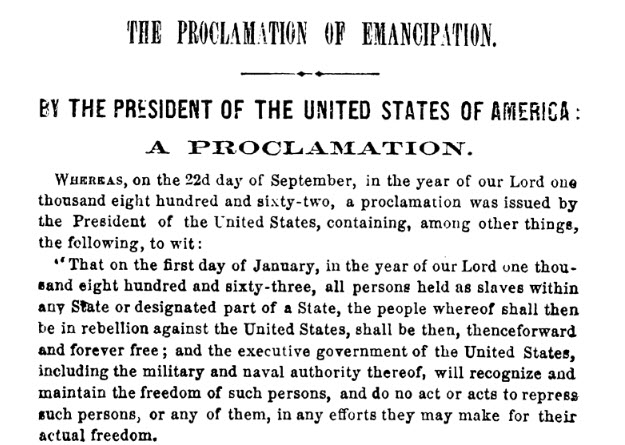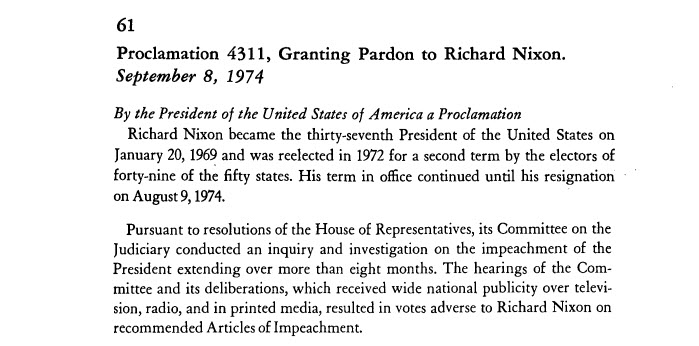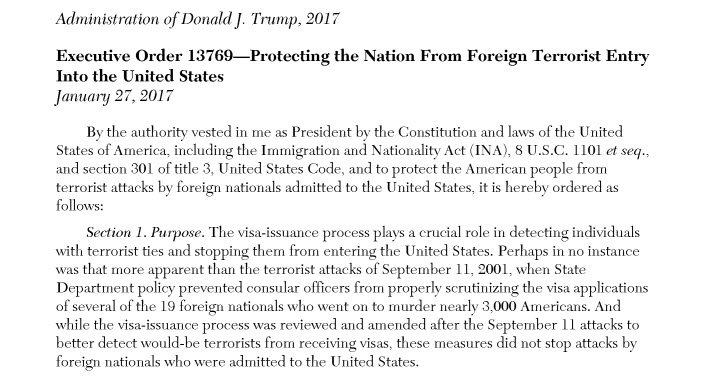On the third Monday of every February, many around the United States honor those who have served as President. First established in 1879 to observe George Washington’s birthday, the holiday has become a catch-all celebration of the highest office in the country.
To celebrate Presidents Day this year, let’s take a look at one of the most effective courses of action for the President of the United States: the executive order. This type of directive, vaguely awarded to the executive branch in Article II, Section 1 of the U.S. Constitution, can cover all sorts of topics as long as it has some basis in the Constitution or federal law.
Once signed, the executive order bears the power of law. Stick around to discover some of the most famous (and infamous) executive orders so far using HeinOnline’s U.S. Presidential Library.
1. The Emancipation Proclamation
Possibly the most famous executive order was issued in a time before the directives were officially numbered. The Emancipation Proclamation of January 1, 1863 was issued by President Abraham Lincoln to declare the freedom of more than three million slaves throughout the Confederacy. Though the order only truly freed slaves in Union-controlled states (about 20-50,000), it provided a framework for the eventual emancipation of millions more as Union armies overtook the Confederates.

2. The Confiscation of Gold
In 1913, the passage of the Federal Reserve Act required the U.S. government to possess a certain amount of gold in order to print paper money. By 1933, with the Great Depression in full swing, President Franklin D. Roosevelt was desperate for a way to increase the government’s cash on hand, necessitating a physical increase in its amount of gold. With Executive Order 6102, Americans were compelled to trade in their personal gold for cash. Many of those who did not comply had their gold seized, were arrested, and served time in jail.
3. A New Agency Under the New Deal
Two years later, President Roosevelt used his executive order privilege once again to bring aspects of his New Deal into reality. For example, the Works Progress Administration (WPA), established by Executive Order 7034, was a new government agency whose purpose was to create jobs for the millions of people unemployed by the Great Depression. Though the WPA existed only for eight years, its workers made monumental improvements to the nation’s infrastructure and cultural life.
4. Facilitating the Manhattan Project
In 1941, President Roosevelt signed another executive order, this time focusing on international relations rather than domestic concerns. A response to the race to create an atomic bomb, Roosevelt’s Executive Order 8807 established the Office of Scientific Research and Development (OSRD). Given unlimited resources for its research, the S-1 Committee of the OSRD would later establish a number of sites around the country, including its Los Alamos Laboratory, where the atomic bomb was designed and tested.
5. Japanese-American Concentration Camps
By the end of 1941, Japan had launched a surprise attack on the U.S. Pacific Fleet at Pearl Harbor. Immediately after the incident, the United States formally declared war on Japan. Soon after, President Roosevelt issued Executive Order 9066, calling for the relocation of all Japanese-Americans on the West Coast to government-run concentration camps. The executive order affected more than 100,000 Japanese Americans overall.

6. Nationalizing America’s Steel Mills
United Steelworkers of America organized a strike in 1952 against U.S. Steel and other producers. Before the strike could begin, however, President Harry S. Truman issued Executive Order 10340 to nationalize all American steel mills, transferring their control to Secretary of Commerce Charles Sawyer. Several of the steel companies sued for control of their mills, and the case went to the U.S. Supreme Court where it was decided that the executive order was unconstitutional.
7. Establishing the Warren Commission
After the tragic assassination of President John F. Kennedy in 1963, newly sworn-in President Lyndon B. Johnson signed Executive Order 11130 to establish the Warren Commission. The Commission would investigate the details of the incident, and determine Lee Harvey Oswald’s motivations and possible connections. Though the Warren Commission determined that Oswald acted alone, the Warren Report sparked great controversy and conspiracy.
8. A Pardon for Nixon
The early 1970s were rocked by the scandalous impeachment of President Richard Nixon. Following Nixon’s resignation, Vice President Gerald Ford assumed the presidency. In one of his first actions in office, Ford signed Proclamation 4311, issuing an unconditional pardon to the disgraced former president from prosecution for any crimes he may have committed.

9. The Creation of FEMA
Before the 1970s, different types of federal disasters were handled by separate government agencies. In some cases, this meant that more than 100 agencies might be attempting to manage a federal emergency at the same time, leading to inefficiency and confusion. In 1979, President Jimmy Carter signed Executive Order 12148 to formally consolidate disaster relief efforts under one new agency—the Federal Emergency Management Agency (FEMA). The organization initially absorbed several other government agencies, and following the attacks of September 11, 2001, took over the newly established Department of Homeland Security.
10. Restricting Access to Presidential Records
During Nixon’s impeachment process, Congress passed the Presidential Recordings and Materials Preservation Act of 1974. Intended to reduce presidential secrecy and preserve history, the legislation transferred Nixon’s records to federal custody. The Presidential Records Act of 1978 went further to declare all records of former presidents as property of the federal government, to be made public 12 years after they left office. When George W. Bush became president, Ronald Reagan’s papers were next on the list. After delaying the deadline for Reagan’s documents to be made public, Bush signed Executive Order 13233, restricting access to presidential records with military, diplomatic, national security, or other sensitive information. The order was later revoked by Barack Obama’s Executive Order 13489.
11. Closing Guantanamo Bay
Guantanamo Bay is a U.S. military prison that was established by President George W. Bush in 2002 to detain, interrogate, and prosecute extraordinarily dangerous criminals. Critics of the detention center claim that the practice of torture and imprisonment without trial is a violation of human rights. On January 22, 2009, President Barack Obama signed Executive Order 13493, calling for a review of all detained individuals and vowing that the prison would close within a year. However, the deadline was not met and Obama’s term ended with the prison still open. In January 2018, President Donald Trump signed his own executive order to keep the prison open indefinitely.
12. Trump’s Immigration Order
Throughout his campaign, President Donald Trump argued that terrorists are manipulating the existing refugee resettlement program to gain entry to the United States. In an effort to limit immigration from “terror-prone regions,” Trump signed the wide-reaching Executive Order 13769 in January of 2017. The order significantly lowered the number of refugees allowed into the U.S. that year and suspended the entry of refugees from countries such as Syria, Iran, Iraq, Libya, Somalia, and more. Because the affected countries were predominantly made up of Muslim citizens, the order was condemned by many and referred to as a “Muslim ban.” The constitutionality of the directive was called into question in Washington v. Trump; as a result, Trump signed a redrafted version of the order, which the Supreme Court upheld.

Want more great content? Get posts like these sent directly to your inbox when you subscribe today.



